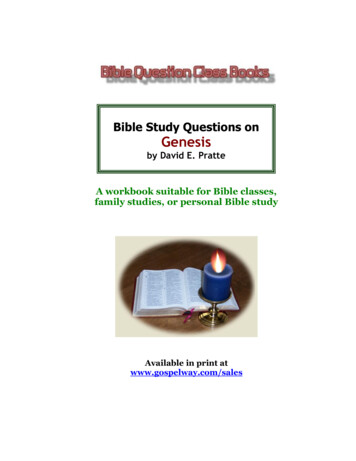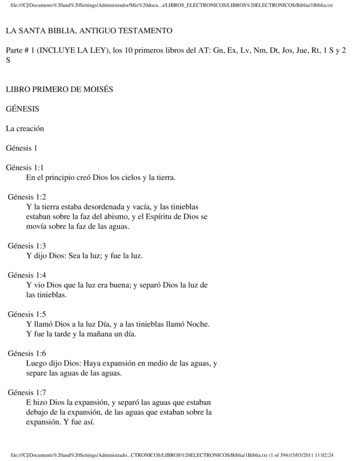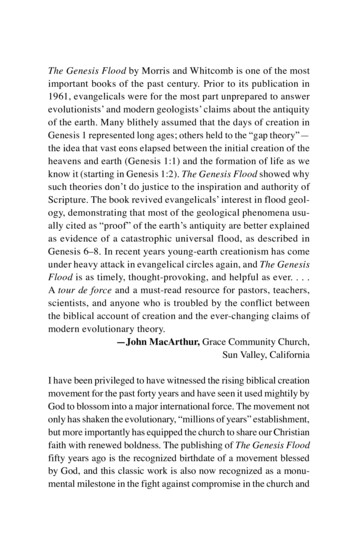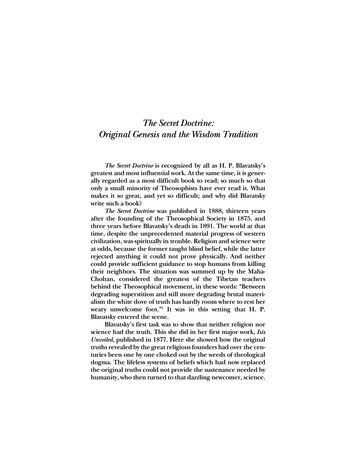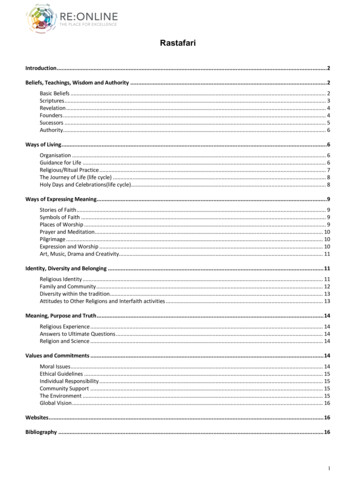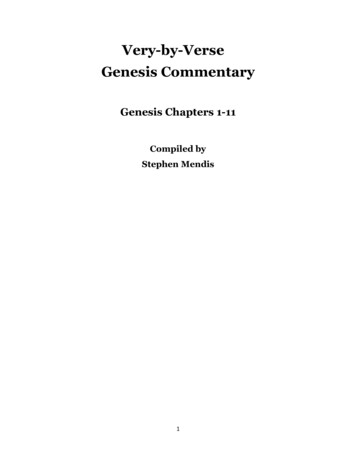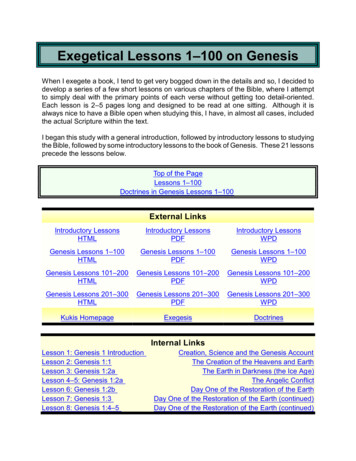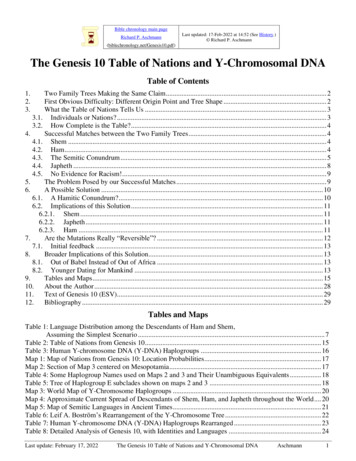
Transcription
Bible chronology main pageRichard P. AschmannLast updated: 17-Feb-2022 at 14:52 (See History.) Richard P. Aschmann(biblechronology.net/Genesis10.pdf)The Genesis 10 Table of Nations and Y-Chromosomal DNATable of Contents1.2.3.Two Family Trees Making the Same Claim . 2First Obvious Difficulty: Different Origin Point and Tree Shape . 2What the Table of Nations Tells Us . 33.1. Individuals or Nations? . 33.2. How Complete is the Table? . 44.Successful Matches between the Two Family Trees . 44.1. Shem . 44.2. Ham . 44.3. The Semitic Conundrum . 54.4. Japheth . 84.5. No Evidence for Racism! . 95.The Problem Posed by our Successful Matches . 96.A Possible Solution . 106.1. A Hamitic Conundrum? . 106.2. Implications of this Solution . 116.2.1. Shem . 116.2.2. Japheth . 116.2.3. Ham . 117.Are the Mutations Really “Reversible”? . 127.1. Initial feedback . 138.Broader Implications of this Solution. 138.1. Out of Babel Instead of Out of Africa . 138.2. Younger Dating for Mankind . 139.Tables and Maps . 1510. About the Author . 2811. Text of Genesis 10 (ESV). 2912. Bibliography . 29Tables and MapsTable 1: Language Distribution among the Descendants of Ham and Shem,Assuming the Simplest Scenario . 7Table 2: Table of Nations from Genesis 10 . 15Table 3: Human Y-chromosome DNA (Y-DNA) Haplogroups . 16Map 1: Map of Nations from Genesis 10: Location Probabilities. 17Map 2: Section of Map 3 centered on Mesopotamia . 17Table 4: Some Haplogroup Names used on Maps 2 and 3 and Their Unambiguous Equivalents . 18Table 5: Tree of Haplogroup E subclades shown on maps 2 and 3 . 18Map 3: World Map of Y-Chromosome Haplogroups . 20Map 4: Approximate Current Spread of Descendants of Shem, Ham, and Japheth throughout the World . 20Map 5: Map of Semitic Languages in Ancient Times . 21Table 6: Leif A. Boström’s Rearrangement of the Y-Chromosome Tree . 22Table 7: Human Y-chromosome DNA (Y-DNA) Haplogroups Rearranged . 23Table 8: Detailed Analysis of Genesis 10, with Identities and Languages . 24Last update: February 17, 2022The Genesis 10 Table of Nations and Y-Chromosomal DNAAschmann1
1.Two Family Trees Making the Same ClaimIf we study the Table of Nations in Genesis chapter 10, and consider what light might be shed on itby modern genetic mapping of world migrations, or vice versa, we realize an important point: the Table ofNations in Genesis 10 (see Table 2 and Map 11) claims to show a family tree of the nations or ethnic groupings, based on descent through the male line only, which is precisely the same claim made for the family treeof Y-Chromosome Haplogroups (see Table 3 and Maps 2 and 3), except of course that instead of nationsthey are genetic groupings called haplogroups. Those of us who believe strongly in the inerrancy of theWord of God believe that the facts laid out in Genesis 10 are true, so if the assumptions that underlie the YChromosome Haplogroup tree are also valid, then we should be able to establish some sort of correspondence. Unfortunately, at first glance no such correspondence is apparent. Is such a correspondence even possible?The structure of the two tables is somewhat different, the Table of Nations being a tree of fathers andsons (or ancestors and descendant peoples),2 causing it to widen out quickly, whereas the Haplogroup treesplits at mutations, making it much narrower. Even so, as I said above, since both tables make the sameclaim, then if both are based on valid assumptions, they should show some clear correlation.2.First Obvious Difficulty: Different Origin Point and Tree ShapeIf we look at Map 1, we see that the descendants of the three sons of Noah seem to spread out from apoint in the Middle East, presumably Babel (i.e. the city of Babylon3), since Genesis 11 suggests that most ifnot all people were situated there during that time.4 The descendants of Japheth went primarily north, thoseof Ham went primarily southwest,5 and those of Shem mainly stayed put in Mesopotamia or went southeast.All three sons clearly had numerous descendants, some of them clearly identifiable even today. Not all of thenames in Genesis 10 can be identified or solidly located on the map, but at least those in red and dark red arefairly solid, making the three-way geographical split fairly clear. And again, the origin point is clearly theMiddle East.However, one thing that the Y-Chromosome Haplogroup tree, as normally presented, claims to havedemonstrated is that mankind originated in Africa, and experienced a significant amount of mutation beforefinally a carrier of the CT (or CDEF) mutation M168, or possibly as late as Haplogroup F (F-M89), traveledout of Africa. These migration patterns can be seen on Map 3. “Y-chromosomal Adam” has recently beenplaced in West Africa, but Dr. Fazale Rana has rebutted this, and suggested that an East African origin bestfits the genetic evidence. This does not match the starting point suggested by Genesis 10, but it is closeenough that it is not too problematic, according to Dr. Rana.This still seems a bit of stretch to me: Babylon is a long way from East Africa.Also, the first split of the table is not three-way, but only two-way, and the table continues to makemainly two-way splits as it goes along. Now this is not fundamentally important, since the splits in the tableare based on mutations, which can occur randomly at any point in a genealogical table. However, since Gen-1In several of the maps and charts, including Table 1, Table 2, and Map 1, the descendants of Shem are highlighted or outlined inyellow , those of Ham in green , and those of Japheth in orange , to allow for easier comparison.2See the discussion of this at the top of Table 8.3The Hebrew term is בָּ בֶ ל /Bāˈḇel/. This clearly refers to the city of Babylon and is almost always translated Babylon in EnglishBibles, but in Genesis 11:9 it is usually translated Babel (and by many translations in Genesis 10:10 also), perhaps to show itssimilarity to the English word “babble”. The origin of its original Akkadian form Babili, earlier Babilli or Babilla is uncertain, butit seems to be related to the Hebrew verb בָּ לַל /bāˈlal/ “confuse”, as is suggested in Genesis 11:9. The English word Babylon isderived from the Greek Βαβυλών, itself from the Akkadian form.4It does not explicitly say that there could not have been a few who separated earlier, obeying God’s command in Genesis 1:28and 9:1 and 7 to “Be fruitful and multiply and fill the earth”. However, since no mention is made of these exceptions of obedienceafter the pattern of Noah, it seems to me that the implication is that all participated.5For a discussion of Nimrod, see Table 8.Last update: February 17, 2022The Genesis 10 Table of Nations and Y-Chromosomal DNAAschmann2
esis 10 makes it clear that all three of Noah’s sons had numerous descendants, it would seem to require thatthe first mutation occurred even before the Flood, in one of Noah’s sons, but not in the other two.However, as we begin actually trying to identify some of Noah’s descendants, and try to match themto current populations, we find that it’s not that simple, in fact we find that we have a serious problem inmatching up the two tables.3.What the Table of Nations Tells UsBut before we look into it, we need to look again at what the Table of Nations in Genesis 10 is tellingus.Sometimes the names in the Table of Nations can be identified with a particular location or region,shown by many of the names in red on Map 1, and in some cases we can identify a particular ethnic/languagegroup by name in this table, such as Javan (the Ionian Greeks), Madai (the Medes), Aram (the Arameans),Elam (the Elamites), Canaan (the Canaanites), or Mizraim (the Egyptians), each of whom had their ownidentifiable language. Some of these stayed in the same place through most of recorded history, speakingessentially the same language,6 like the Egyptians, though their original language (Coptic) died out as a spoken language in the 17th century, being replaced by Arabic, though it survives as the liturgical language ofthe Coptic Church.In other cases, as in the names in light gray on Map 1, we have very little or no information eitherabout where they lived or about what language they spoke. And those in dark red and charcoal fall somewhere in-between.3.1.Individuals or Nations?But aren’t some of the names in the table individuals rather than nations? And shouldn’t the nonterminal names in Table 2 be assumed to be part of a genealogy of individuals, including at least the thirdcolumn, Noah’s “grandsons”? Not necessarily, as I explain in the introduction to Table 8: most of the knownnames seem to refer to nations or ethnic groups, so may not refer to individuals at all.However, to answer the first question, yes, certainly some of the names in the table are individuals.Noah is certainly an individual, as seen all the way through Genesis 6-9. And Shem, Ham, and Japheth areclearly individuals, and are clearly the first generation sons of Noah, because they were among the 8 peoplewho lived on the ark for a year, along with each of their wives, and acted individually and distinctly in thestory of Noah’s drunkenness in Genesis 9:18-28. Canaan, on the other hand, even though he is mentionedrepeatedly in the latter passage, and even though he is specifically cursed because of Ham’s actions, neveractually appears as an individual actor in the story, so the curse could just as easily be upon a nation ratherthan an individual. Granted, he may also have been the individual who founded the ethnic group that eventually became the Canaanites, but the table cannot be used to prove this one way or the other.In fact, beyond Shem, Ham, and Japheth themselves, no single name in the table comes into focus asan individual actor except for Nimrod, and his case is unique, as I explain in Table 8.7 (Even so, it seemsclear that Abram’s ancestors from Arpachshad down to Peleg are individuals, since they are also listed inAbram’s genealogy in Genesis 11, which seems to be a list of individuals from start to finish; also, thoughElam, Asshur, Lud, and Aram all seem to be the names of known nations or cities, as do many of the other“descendants” of Shem, Arpachshad does not.)However, these have all changed greatly through time. See my article God Doesn’t Have Favorite Languages for a detailed explanation of this.7Keil and Delitzsch contend that Sidon in verse 19 must also be an individual, mainly because he is called Canaan’s “firstborn”,though even here the NIV footnote suggests another interpretation: “Canaan was the father of the Sidonians, the foremost”, whichwould be an accurate description. By tradition it was also the oldest city in Phoenicia, according to Wiseman in the New BibleDictionary, which could also be the meaning. A second reason they give is that, though 9 out of the 11 “descendants” of Canaanare expressed as national or ethnic groups ending in “-ite(s)”, Sidon and Heth are listed as if they were individuals. However, as Idiscuss in the following paragraphs, this does not prove that they were, since some such names almost certainly were not.6Last update: February 17, 2022The Genesis 10 Table of Nations and Y-Chromosomal DNAAschmann3
This all suggests that, unless we have evidence to the contrary, most of the names in the table shouldbe assumed to be nations or ethnic groups rather than individuals. (This does not preclude the possibility thatin some cases an individual was indeed the founder of a nation, which took his name, but in at least a fewcases this is not likely, as in the case of the mixed nations of Sheba and Havilah. In any case, for convenience I will often treat them as individuals, referring to “the descendants of Aram”, without resolving thequestion.) This implies that the columns in Table 2 should not be assumed to be generations at all, but simplylines of descent.Even so, the argument of this article still holds true, that the table demonstrates descent from Shem,Ham, and Japheth through the male line, since only the male line counted in the ancient world, and in biblical genealogies.3.2.How Complete is the Table?Should the table be assumed to be complete in the sense of covering the whole world’s ethnic groupsat the time it was made? Evidently not: all of the nations that can be identified are geographically close to thenation of Israel, and for most we have at least fairly good evidence of their location. This suggests that theintent of the table was only to show the descent of those nations that were generally familiar to the peoples ofthe Middle East. Moses evidently wrote Genesis during the Israelites’ sojourn in the wilderness in the 15 thcentury B.C. (see Aschmann.net/Bible Chronology). There is no question that at that time every continentexcept Antarctica was already well populated by humans, but there seems to be no attempt in the table to include any but the nearby nations.In §6.1 we shall deal with this question again.4.Successful Matches between the Two Family TreesIf we compare Map 1 with Map 2 (which is one section of Map 3), when we attempt to match someof the people groups on Map 1 with those on Map 2, we find that we can do so with some certainty for a fewof them, especially for the descendants of Shem and Ham, though tentatively also with Japheth. In particular,we find that for each of Noah’s sons there is at least one Y-chromosome haplogroup that we can fairly reliably associate with some of their descendants, even though nearly all of the other haplogroups cannot be soassociated. (For all of the discussion that follows, please consult the haplogroups listed in Table 4 below aswe go along.)4.1.ShemFor Shem we have a huge clue, and that is that science has established that haplogroup J-P58, alsoknown as the Cohen Modal haplotype, is evidently the haplogroup of Aaron, the ancestor of the Jewishpriestly line. This haplogroup is a descendant of Haplogroup J-M267 (J1), which from Map 2 we can see isprimarily found in the southern part of the Middle East, precisely the area that was populated by Abrahamand his relatives and descendants. We can also see that its sister haplogroup J-M172 (J2) is found primarilyin Mesopotamia, the other major area populated by descendants of Shem, as seen in Map 1. Thus, I wouldsay that we can affirm with some confidence that Haplogroup J (J-M304), the parent of these two groups, isundoubtedly descended from Shem.4.2.HamIf we look at Map 1, we immediately see that Ham is largely confined to Africa, except for a fewplaces where it spills over into Asia, notably the eastern end of the Mediterranean and parts of western Arabia, and one Mediterranean island, Crete. On the other hand, neither Shem nor Japheth has any presence inAfrica, except for the very tentative Ophir. If we then look at Africa on Map 3, one haplogroup immediatelyjumps out at us as occupying most of Africa, and very little outside Africa: haplogroup E (E-M96). And weobserve an interesting thing about this haplogroup: it corresponds very closely to two of the world’s mostimportant language families: The Afro-Asiatic language family, spoken mainly in North Africa and the MidLast update: February 17, 2022The Genesis 10 Table of Nations and Y-Chromosomal DNAAschmann4
dle East, and the Niger-Congo language family, spoken in much of Sub-Saharan Africa, though it apparentlyoriginated in Sub-Saharan west Africa, and probably only began occupying southern Africa around 1000B.C. with the Bantu expansion, displacing many older populations there, of whom remnants still remainacross the area. If we compare a map showing the language families of Africa with Map 3, we see how consistent this correspondence is, with only a few exceptions. In fact, these language families were listed onMap 3 because its creator was well aware of these correspondences.It is not possible to identify any of the speakers of the Niger-Congo languages with any of the peoples of Genesis 10, but it turns out that quite a few of the peoples who speak, or have historically spoken,Afro-Asiatic languages can be clearly identified with descendants of Ham, among them the Egyptians(speaking the Egyptian language, whose modern descendant is Coptic); the kingdom of Cush, whose writtenlanguage, Meroitic, though undeciphered, shows evidence of being Afro-Asiatic, and in fact probably belonged to the Cushitic subfamily of Afro-Asiatic languages, still spoken widely in the same area, and as farsouth as Somalia and Kenya; and even Put (or Phut), which Josephus and other ancient sources associatedwith Ancient Libya, which spoke languages in the Berber subfamily of Afro-Asiatic, still widely spoken innorth Africa.I would submit that this provides sufficient evidence that the carriers of haplogroup E (E-M96) areclearly descended from Ham, which would include the speakers of the Niger-Congo languages and thespeakers of most of the subfamilies of Afro-Asiatic languages.4.3.The Semitic ConundrumHowever, of the six subfamilies of the Afro-Asiatic languages, one of them presents us with a conundrum, the Semitic languages,8 a conundrum not just for Genesis 10, but for genetic studies in general. Andthis is because the speakers of the Semitic subfamily of Afro-Asiatic are consistently and overwhelminglydescended not from haplogroup E (E-M96), but from Haplogroup J (J-M304) that we have discussed above,and are mainly descendants of Shem as described in Genesis 10. This includes Aram, whose descendantsspoke Aramaic (still spoken today), and Asshur, whose descendants spoke the ancient Assyro-Babylonianlanguage called Akkadian (now extinct). Some of the descendants of Arpachshad, specifically the descendants through Joktan, seem to have moved south into the Arabian Peninsula and formed their own subgroup ofSemitic, the South Semitic languages (with descendant languages still spoken today),9 as we shall see inTable 8. The other descendants of Arpachshad, through Peleg, seem to have spoken the Aramaic languagealong with the descendants of Aram. Abraham’s family was in this group, and spoke Aramaic, but subsequently adopted the Canaanite language after they moved to Canaan, and this then developed into the Hebrew language. Abraham’s relatives that remained in Haran never spoke Hebrew.10However, of course it couldn’t be as simple as that all of the descendants of Shem spoke Semitic languages: the Elamites, descendants of Elam, spoke a language, Elamite, that was written for many centuries,and is well understood, but which does not seem to be related to any other language; it is now extinct. As forLud, we do not know for certain who his descendants were or what language they spoke.To complicate matters even more, the descendants of one of Ham’s sons, Canaan, spoke a Semiticlanguage, Canaanite, with many similarities to Aramaic, though clearly a different language from its earliesthistory. The Israelites, a Semitic people, adopted this language and developed it into Hebrew, after which8See Map 5 to see the locations of the Semitic languages in ancient times with some of the Biblical connections mentioned in thissection.9The Semitic languages of Ethiopia and Eritrea, which are also in the South Semitic subfamily, and the corresponding strong presence of Haplogroup J-M267 (J1), suggest that the speakers of these languages also are descendants of Joktan, and their traditionslargely confirm this, claiming a connection to Sheba. However, the only name in Shem’s table that is normally placed in Africa isOphir. Whether these correspond or not is unclear.10This is explained in excruciating technical detail in the Appendix at the end of my article When Was Hebrew First Written? Additional (non-technical) information can be found in God Doesn’t Have Favorite Languages.Last update: February 17, 2022The Genesis 10 Table of Nations and Y-Chromosomal DNAAschmann5
most of the Canaanites were either wiped out by the Israelites or were absorbed into later cultures. Quite aconvoluted story, isn’t it?11So what happened here? Going back to the Afro-Asiatic languages, this is probably the oldest language family that it has been possible to reconstruct using the comparative method,12 perhaps some 12,000years old (estimates range from 9,500 to 18,000 years old). In other words, around 10,000 B.C. there was asingle language, which linguists call the Proto-Afro-Asiatic language, which gradually changed through theyears as its speakers spread out and moved around, until it diversified into all of the highly divergent languages in the family today.So, were the speakers of that original Proto-Afro-Asiatic language descendants of Ham or descendants of Shem? We do not know, but it seems probable that they were descendants of Ham, given that five ofthe six subfamilies are African and Hamitic. Where did they live? We have no idea, but again probablysomewhere in northeast Africa. Why did some (but not all) of the Semitic peoples adopt the language of aseparate ethnic group without merging with that group, as is evidenced by the fact that their form of AfroAsiatic later diverged from the others? And how is it that the Canaanites, a Hamitic group, ended up speaking the variety used by the Semites? We don’t know, but many times throughout history a people has abandoned its own language because of conquest or intermarriage or even just for commercial or prestige reasons.13 We really know very little about the history of these peoples and their languages before the first AfroAsiatic language, Egyptian, was first written down using Egyptian hieroglyphics around 2700 B.C., exceptwhat we can learn by comparing their languages and studying their geographic distribution, and that information is obviously limited. Occasionally archeology can provide some clues also, but assigning archeological remains to language groups is very uncertain.The simplest scenario might be that the language borrowing didn’t occur twice but only once: that theHamitic Canaanites’ variety of Afro-Asiatic diverged from the others over time, as they moved from Africainto southwest Asia,14 and then for unknown reasons a large portion of the Semites, including the descendants of Asshur, Arpachshad, and Aram (but not Elam,15 and probably not Lud) adopted this language, afterwhich the Semitic forms and Canaanite diverged from each other over more time.16 This seems to be the simplest solution according to Occam’s razor, requiring only one case of a people abandoning their languageinstead of two. (I have laid out the details of this idea in Table 1.)11Actually several other Hamitic groups evidently also spoke Semitic languages, including all of those Hamitic groups shown onMap 1 who settled in the Arabian Peninsula, all of which were descendants of Cush, notably Dedan and Havilah, but less is knownabout these, so my argument will focus on Canaan. These will all be discussed below.12However, the recently reconstructed Dené–Yeniseian language family may have a similar age. It is composed of two groups oflanguages that would have remained largely isolated throughout their history, which would have reduced the amount of languagechange occurring, facilitating the reconstruction.13One pertinent example of this is Abraham’s family, who abandoned their native Aramaic and adopted the Canaanite language,for the simple reason that they now lived in Canaan, even though by God’s grace they were able to avoid being absorbed into Canaanite culture.14Whether Dedan and Havilah’s descendants, mentioned in footnote 11, accompanied Canaan’s descendants, or were a later migration, is unknown, but this does not affect my scenario. The other Hamitic groups that settled in the Arabian Peninsula wereprobably later migrations, as we will see below.15Since we are speculating, this might suggest that the previous language of the Semitic people was the ancestral form of theElamite language mentioned above, though of course the descendants of the various sons of Shem might not even have been giventhe same language at the Tower of Babel.16This divergence would have begun perhaps about 3750 B.C., a reasonable estimate for the date of Proto-Semitic (which,assuming this scenario, we should now call something else, like Ancestral Canaanite), because by 2800 B.C., when the firstAkkadian proper names were attested in Sumerian texts, Akkadian had already diverged from the rest to form the easternsubfamily.Last update: February 17, 2022The Genesis 10 Table of Nations and Y-Chromosomal DNAAschmann6
Table 1: Language Distribution among the Descendants of Ham and Shem,Assuming the Simplest ScenarioHam ProtoAfroAsiaticlanguage Put?Mizraim?CushdescendantsCanaan move to AsiaBerberChadicEgyptianOmoticCushiticHavilah Dedan “Semitic”(AncestralCanaanite) Arabic languages a CanaaniteNorth- languagesCentraladopts CanaanitewestShemAram descendants of threeArpachshad sons ofProto Elamite bShem adoptAsshur “Semitic” language?Elam LudArabicA.N.ArabianPhoenicianCanaanite Semitic Semitic Peleg Aramaic Joktan c South Semitic East SemiticHebrew moves to Canaan, Abraham’s familyNahor’s family remains in HaranElamite ?In the table above and in the text and notes below, bold face and thick colored lines indicate people groups or familylines and the Arial font and thin black lines indicate languages and language families and subfamilies. Dotted red lines indicatepeople groups who have adopted a language different from that of their forefathers.Four of the subfamilies of Afro-Asiatic can with some certainty be assigned to the four sons of Ham, leaving two unassigned. Given their geographic locations, it is possible that Chadic also descended with Berber from Put, and Omotic withCushitic from Cush, though we cannot be certain. And of course we have no information at all about which son(s) the NigerCongo family might have descended from, or exactly what God might have done at the Tower of Babel to bring about the currentdistribution.I have not included either the Ugaritic or Amorite languages in the above chart. Ugaritic was clos
May 18, 2020 · similarity to the English word “babble”. The origin of its original Akkadian form Babili, earlier Babilli or Babilla is uncertain, but it seems to be related to the Hebrew verb ל ַלָּב /bāˈlal/ “confuse”, as is suggested in Genesis 11:9. The English word Babylon is der

